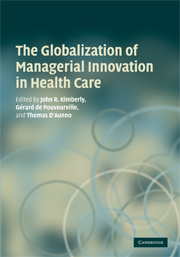Book contents
- Frontmatter
- Contents
- List of figures
- List of tables
- List of contributors
- Acknowledgements
- Introduction
- 1 Origins of DRGs in the United States: A technical, political and cultural story
- 2 Casemix in the United Kingdom: From development to plans
- 3 Casemix implementation in Portugal
- 4 From naïve hope to realistic conviction: DRGs in Sweden
- 5 Casemix in Denmark
- 6 DRGs in France
- 7 Introduction and use of DRGs in Belgium
- 8 DRGs in Germany: Introduction of a comprehensive, prospective DRG payment system by 2009
- 9 Casemix in Switzerland
- 10 The first decade of casemix in Italy
- 11 Casemix development and implementation in Australia
- 12 Diagnosis procedure combination: The Japanese approach to casemix
- 13 Casemix in Singapore
- 14 Experiences with the application of the DRG principle in Hungary
- 15 Casemix systems – past, present, and future: The Canadian experience
- 16 Conclusions: The global diffusion of casemix
- Index
2 - Casemix in the United Kingdom: From development to plans
Published online by Cambridge University Press: 24 February 2010
- Frontmatter
- Contents
- List of figures
- List of tables
- List of contributors
- Acknowledgements
- Introduction
- 1 Origins of DRGs in the United States: A technical, political and cultural story
- 2 Casemix in the United Kingdom: From development to plans
- 3 Casemix implementation in Portugal
- 4 From naïve hope to realistic conviction: DRGs in Sweden
- 5 Casemix in Denmark
- 6 DRGs in France
- 7 Introduction and use of DRGs in Belgium
- 8 DRGs in Germany: Introduction of a comprehensive, prospective DRG payment system by 2009
- 9 Casemix in Switzerland
- 10 The first decade of casemix in Italy
- 11 Casemix development and implementation in Australia
- 12 Diagnosis procedure combination: The Japanese approach to casemix
- 13 Casemix in Singapore
- 14 Experiences with the application of the DRG principle in Hungary
- 15 Casemix systems – past, present, and future: The Canadian experience
- 16 Conclusions: The global diffusion of casemix
- Index
Summary
Introduction to the UK healthcare system
UK healthcare is dominated by the National Health Service (NHS). This was established in 1948 and financed by general taxation. The OECD reported that in 2002 the UK spent 7.7 per cent of its GDP of which public expenditure accounted for 83.4 per cent of the total. The spending had increased from the 1993 figure of 6.9 per cent of GDP.
Under the UK government's NHS Plan, record levels of increased funding for the NHS were planned to rise over the period 2003/4 to 2007/8 by an average of 7.4 per cent a year in real terms. By 2004/5 total spend on the NHS totalled £82.5 billion (7.01% of GDP), up from £66.2 billion in 2002–3 (6.26% of GDP).Figure 2.1 shows the increase in government health expenditure and the percentage of GDP from 1987/8 to 2004/5.
The public healthcare sector in the UK is divided into four principal National Health Services (NHS) for England, Scotland, Northern Ireland and Wales. Each of these services, whilst following the founding principle of the NHS to provide healthcare free at the point of service to all, has differences in policy dictated by the four different legislative and political assemblies for each of the member countries. These differences include free prescription charges in Wales, free elderly personal nursing care in Scotland, and differences in the strategic structures of hospitals and commissioning organisations.
- Type
- Chapter
- Information
- Publisher: Cambridge University PressPrint publication year: 2008



